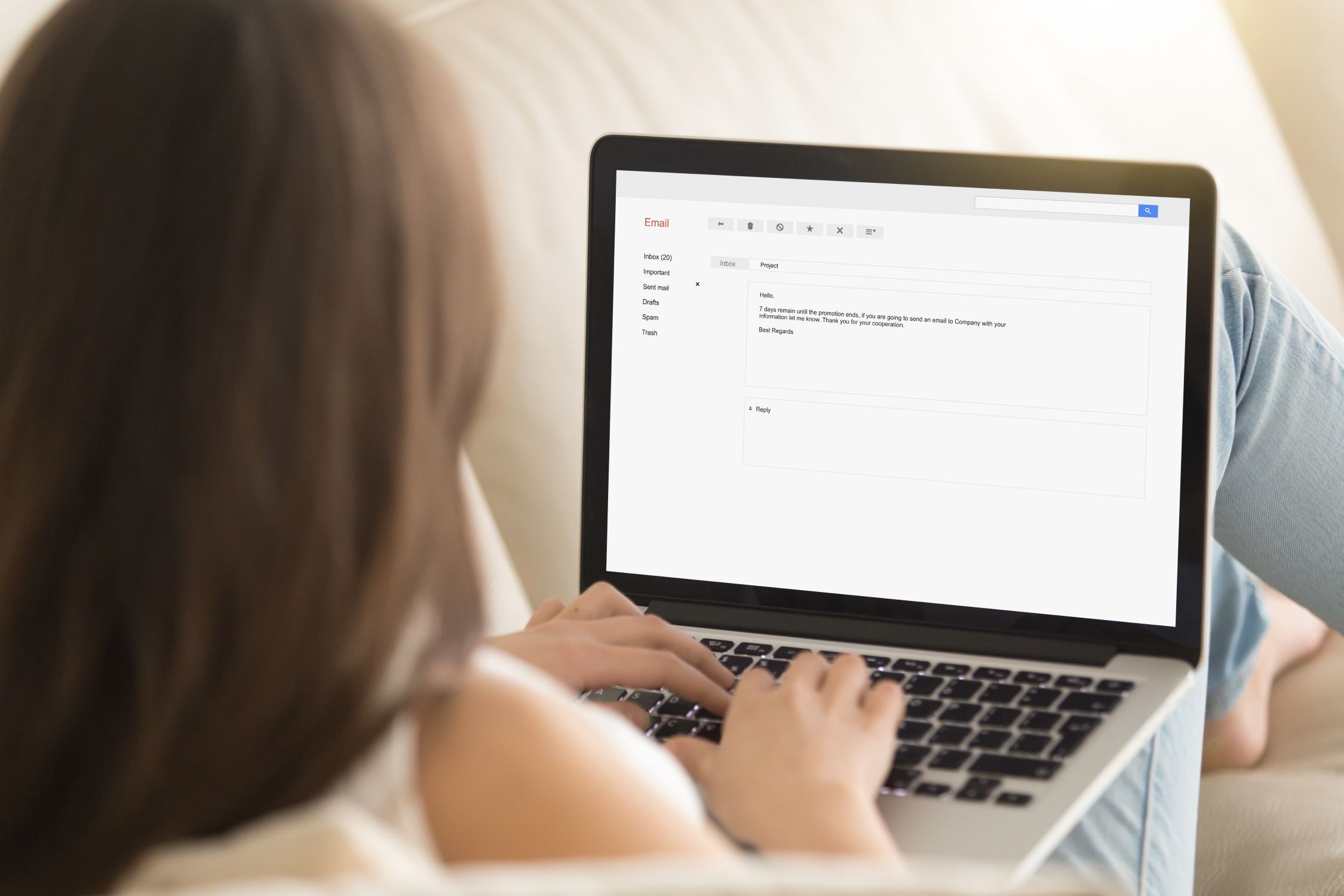Introduction
When it comes to communicating with your professor, sending an email is a crucial skill you need to master. Whether you’re seeking clarification, asking for a meeting, or discussing course-related matters, writing a professional and effective email can make a big difference in how your message is received. But how do you craft an email that grabs your professor’s attention and gets you the response you need?
In this article, we will provide you with valuable tips and guidelines on how to write an effective email to a professor. From doing your research to ensuring proper grammar and etiquette, we will cover all the essential elements of crafting a well-structured and respectful email. By following these recommendations, you will increase the chances of receiving a prompt and helpful response from your professor.
It is important to approach each email to your professor with the utmost professionalism and respect. Keep in mind that your professor is a busy individual with a plethora of responsibilities, so your email should be concise, clear, and focused. Additionally, remember to include all the necessary information to facilitate a proper understanding of your request or inquiry. With these key principles in mind, let us delve into the details of composing an email that will make a positive impression on your professor.
Do Your Research
Before you begin writing your email, take some time to gather relevant information about your professor and the course. This will demonstrate your sincerity and show that you value their time and expertise. Here are a few research tips to consider:
- Familiarize yourself with your professor’s background: Look up their academic qualifications, research interests, and any notable publications. This will give you a better understanding of their expertise and can help you tailor your email accordingly.
- Review the course syllabus: Read through the syllabus and course materials to ensure that your question or concern hasn’t already been addressed. This will help you avoid asking redundant or easily answerable questions.
- Explore the professor’s preferred communication method: Some professors may prefer to be contacted through email, while others may prefer in-person meetings or office hours. Research their preferred method to ensure that your email is appropriate and will receive a timely response.
Taking the time to conduct research not only shows respect for your professor’s time but also enables you to ask more informed and thoughtful questions. This will leave a positive impression and increase the likelihood of receiving a helpful response.
Use a Professional Email Address
When emailing your professor, it is crucial to use a professional email address that reflects your name or identity. Avoid using personal or unprofessional email addresses that may undermine the credibility of your message.
Ideally, your email address should consist of your first and last name or a variation thereof. If your name is already taken, consider adding a number or a relevant term, such as your field of study or graduation year. This will help create an email address that is both professional and unique to you.
By utilizing a professional email address, you convey a sense of professionalism and seriousness in your communication. It allows your professor to identify and associate your message with you as a student, enhancing the overall effectiveness of your email.
If you currently have an unprofessional email address, it is advisable to create a new one specifically for academic and professional purposes. Numerous email service providers offer free email accounts, making it easy to create a new one that will appropriately represent you to your professors and potential employers in the future.
Remember, your email address is the first impression your professor will have of you, even before they read the content of your email. Therefore, it is worth investing a little time and effort to establish a professional email address that will set the right tone for your communication.
Begin with a Proper Salutation
The salutation is the opening line of your email and sets the tone for the rest of your communication. It is important to start your email with a respectful and appropriate salutation that addresses your professor correctly.
If you are unsure of how to address your professor, it is recommended to use their formal title, such as “Dr.” or “Professor,” followed by their last name. For example, “Dear Dr. Smith” or “Dear Professor Johnson.” Using a formal salutation demonstrates respect and acknowledges the authority and expertise of your professor.
However, if your professor has specified a different preference or has provided a preferred name, it is essential to follow their instructions. Some professors may prefer to be addressed by their first name or a nickname. In such cases, adjust your salutation accordingly. For example, “Dear John” or “Dear Jane.”
Avoid using generic or informal salutations like “Hey” or “Hi” unless your professor has explicitly encouraged this level of informality. Keep in mind that when in doubt, it is better to err on the side of formality and show respect through your salutation.
Additionally, if you are writing a follow-up email or have already corresponded with your professor in the past, it is advisable to use a more specific salutation. For example, “Dear Dr. Smith,” “Hello Professor Johnson,” or “Good morning Dr. Brown.” This helps to establish a connection and reminds your professor of your previous communication.
By beginning your email with a proper salutation, you display professionalism, courtesy, and respect for your professor. It sets a positive tone for the rest of your email and increases the likelihood of receiving a favorable response.
Be Clear and Concise in Your Message
When composing your email to a professor, it is essential to be clear and concise in your message. Professors receive numerous emails each day, so it is crucial to communicate your point effectively without overwhelming them with unnecessary information. Here are some tips to help you achieve clarity and conciseness in your email:
- State the purpose of your email upfront: Begin your email by clearly stating the reason for contacting your professor. This allows them to quickly understand the purpose of your message.
- Use a concise subject line: A well-crafted subject line can help grab the attention of your professor and provide a preview of your email’s content. Keep it brief and relevant.
- Organize your thoughts: Break your email into paragraphs or bullet points to make it easier to read and comprehend. Each paragraph or point should focus on a specific topic or question.
- Use clear and direct language: Avoid using overly complicated or flowery language. Be straightforward and use plain language to ensure your message is easily understood.
- Avoid rambling: Be mindful of the length of your email. Stick to the necessary information and avoid excessive details or irrelevant tangents.
- Highlight key information: If there are specific dates, times, or deadlines that need to be addressed, make them stand out by bolding or underlining them.
By being clear and concise, you demonstrate respect for your professor’s time and make it easier for them to address your concerns or questions. Remember, they are more likely to respond promptly if they can easily understand the purpose of your email and the specific information you are seeking.
Use Proper Grammar and Spelling
When communicating with your professor through email, it is crucial to use proper grammar and spelling. Your email is a reflection of your professionalism and attention to detail, so it is essential to ensure that your message is free from errors. Here are some tips to help you maintain proper grammar and spelling in your email:
- Proofread your email: Before sending your email, take the time to read through it carefully. Check for any grammatical errors, spelling mistakes, or typos. Consider using online grammar and spell-check tools to assist you.
- Use complete sentences: Avoid using fragments or run-on sentences. Ensure that each sentence in your email is clear and grammatically correct.
- Pay attention to punctuation: Use punctuation marks, such as commas and periods, appropriately. Incorrect punctuation can lead to confusion or alter the meaning of your message.
- Check your spelling: Spelling mistakes can make your email appear unprofessional and distract from your message. Double-check the spelling of words, particularly names and technical terms.
- Avoid abbreviations and slang: Use proper language and avoid using informal abbreviations or slang words that may be confusing or inappropriate in an academic setting.
- Consider your tone: Use proper grammar to convey a professional and respectful tone in your email. Be conscious of your word choice and sentence structure to ensure clarity and appropriate formality.
Remember, your email represents you as a student, so it is crucial to present yourself in the best possible light. By using proper grammar and spelling, you convey professionalism and attention to detail, which can positively influence your professor’s perception of you.
Be Polite and Respectful
When writing an email to your professor, it is vital to maintain a polite and respectful tone throughout your message. Your professor is an authority figure and deserves to be treated with courtesy and professionalism. Here are some tips to help you express politeness and respect in your email:
- Use appropriate language: Ensure that your language is polite and professional. Avoid slang, offensive language, or disrespectful comments.
- Address your professor respectfully: Begin your email with a proper salutation, using the appropriate title (e.g., Dr., Professor) and their last name. This shows respect and acknowledges their position.
- Show gratitude: If your professor has helped you in the past or if you are requesting their assistance, it is important to express your gratitude. Thank them for their time and consideration.
- Use pleasantries: Begin or end your email with a polite greeting, such as “Hope you are doing well” or “I hope this email finds you well.” This adds a personal touch and creates a positive rapport.
- Avoid demanding language: Instead of using demanding phrases like “I need you to do this,” use more courteous language such as “Could you please consider…” or “I would appreciate your guidance on…”
- Be patient and understanding: Professors have busy schedules, so it is important to be patient if they don’t respond immediately. Avoid sending follow-up emails too quickly and give them ample time to address your query.
Remember, your professor is more likely to respond positively if you approach them with respect and politeness. By maintaining a courteous tone, you establish a professional relationship and create a favorable impression of yourself as a diligent and respectful student.
State Your Purpose Clearly
One of the most important elements of writing an email to a professor is stating your purpose clearly. Your professor receives numerous emails daily, so it’s crucial to convey your message concisely and directly. Here are some tips to help you state your purpose clearly in your email:
- Use a clear and concise subject line: The subject line should provide a brief summary of your email’s purpose. Make it specific and relevant to grab your professor’s attention.
- Begin with a direct statement: In the opening sentence of your email, clearly state the reason for reaching out. For example, “I am writing to request a meeting to discuss my research project” or “I have a question regarding the upcoming assignment.”
- Provide context if needed: Depending on the nature of your request or inquiry, it may be helpful to provide some background information or context. However, be mindful not to include excessive details that may distract from your main point.
- Be specific about what you need: Clearly indicate your expectations and the specific information or assistance you need from your professor. This will help them address your request more effectively.
- Ask any relevant questions: If you have specific questions, enumerate them clearly and concisely. This allows your professor to respond to each question individually and ensures that no queries are overlooked.
- Avoid vague language: Be precise and avoid ambiguity in your email. Instead of saying, “I was wondering if you could help me,” say, “Could you please provide guidance on…” or “I would appreciate your feedback on…”. This clarity increases the chances of receiving a clear response.
By clearly stating your purpose, you demonstrate professionalism and respect for your professor’s time. It allows them to quickly understand the nature of your email and respond accordingly. Remember to keep your email focused and well-structured to avoid any confusion and ensure a successful outcome.
Provide Necessary Information
When writing an email to a professor, it is important to provide all the necessary information to ensure that your request or inquiry is understood clearly. By including relevant details, you save time for both yourself and your professor. Here are some essential guidelines to follow when providing necessary information in your email:
- Identify yourself: Begin your email by introducing yourself and stating the course or program you are enrolled in. This helps your professor identify you and puts your email into context.
- Include important dates or deadlines: If your email pertains to a specific assignment, project, or upcoming event, make sure to mention the relevant dates or deadlines. This ensures that your professor understands the time sensitivity and can provide timely assistance or feedback.
- Specify any attachments: If you are including any attachments, such as documents, research papers, or project drafts, mention them in the email. Provide clear instructions on how your professor should review or access the attachments.
- Cite relevant course or class information: When seeking clarification or discussing course-specific topics, it can be helpful to reference specific readings, lecture topics, or discussions that relate to your inquiry. This allows your professor to relate your question to the course material more easily.
- Include your preferred contact method: If you have a preference for how your professor should respond to your email (e.g., email, phone call, virtual meeting), state it clearly. This ensures that there is no confusion regarding the communication method.
- Mention any previous correspondence: If your email is a follow-up to a previous conversation or email exchange with your professor, briefly reference it to provide context and continuity. This makes it easier for your professor to recall the previous discussion and respond accordingly.
By providing all the necessary information, you facilitate better understanding and enable your professor to address your concerns or inquiries more effectively. It saves both parties time and ensures that the communication is clear and fruitful.
Use a Professional Closing
Just as a proper salutation is important for starting your email, using a professional closing is equally essential to leave a positive impression. It adds a final touch of professionalism and courtesy to your message. Here are some tips for using a professional closing in your email:
- Choose an appropriate closing phrase: Common professional closing phrases include “Sincerely,” “Best regards,” or “Thank you.” Select one that aligns with the tone and formality of your email.
- Sign off with your name: After your closing phrase, type your full name to signify your identity. If your email address does not already contain your real name, this serves as a reminder to your professor of who is contacting them.
- Include your contact information: If your email address does not clearly indicate your full name or if you can provide additional contact information, such as a phone number, you may include it after your name. This makes it easier for your professor to reach out to you if necessary.
- Consider an email signature: If your email client offers the option, you can create an email signature that includes your name, contact information, and any other relevant details, such as your major or the degree you are pursuing. This provides a professional touch to your email.
Using a professional closing not only wraps up your email with politeness and respect but also adds a personal touch that can leave a lasting impression. It shows that you have taken the time to compose a well-thought-out message and that you value your professor’s time and expertise.
Proofread and Revise Before Sending
Before you hit the send button, it is crucial to proofread and revise your email. Even a single typo or grammatical error can undermine the professionalism of your message. Take the time to review your email carefully to ensure it is error-free and accurately conveys your intended message. Here are some tips for proofreading and revising your email:
- Check for spelling and grammar errors: Use a spell-check tool and read through your email word by word to identify any spelling mistakes or grammatical errors. Pay attention to homophones, verb tense consistency, and subject-verb agreement.
- Ensure clarity and coherence: Read your email to ensure it flows smoothly and makes sense. Check for any confusing or ambiguous sentences, and rephrase them as needed to enhance clarity.
- Review the structure and organization: Ensure that your email is well-structured with paragraphs or bullet points where appropriate. Each paragraph should focus on a single topic or question to avoid confusion.
- Check for proper formatting: Confirm that any formatting you have used, such as bolding or underlining, is consistent and enhances the readability of your email.
- Consider the tone and tone: Reflect on the overall tone of your email and make sure it is respectful and professional. Avoid any language or statements that may be interpreted as unprofessional or offensive.
- Read your email aloud: Reading your email aloud can help you catch any awkward phrasing or errors that you may have missed while silently reading. This technique can also help you gauge the overall tone and flow of your message.
By taking the time to proofread and revise your email, you demonstrate attention to detail and a commitment to effective communication. It shows your professor that you have put effort into crafting a well-written and professional email, increasing the likelihood of receiving a positive response.
Follow Up If Necessary
After sending your initial email, it is important to be proactive and follow up if you do not receive a response within a reasonable timeframe. While your professor may have a busy schedule, they may have unintentionally missed your email or simply require a gentle reminder. Here are some guidelines for following up on your email:
- Wait for an appropriate amount of time: Give your professor a reasonable timeframe to respond before following up. This can vary depending on the urgency of your request, but a general rule of thumb is to wait at least one week.
- Compose a polite follow-up email: Craft a concise and polite follow-up email to gently remind your professor of your previous email. Begin by expressing your understanding of their busy schedule and restate your request or question.
- Keep it brief and to the point: In your follow-up email, avoid restating the entire content of your initial email. Instead, focus on the key points and politely inquire if they have had a chance to review your previous message.
- Be understanding and flexible: Acknowledge that your professor may have various commitments and other priorities. Express your flexibility and willingness to discuss your concerns or questions at a convenient time for them.
- Resend the original email if necessary: In some cases, there may have been a technical issue with your initial email, causing it to be missed or overlooked. If you suspect this is the case, politely ask if you could resend your original email for their review.
Remember, following up on your email shows your persistence and dedication to receiving a response. However, it is important to maintain professionalism and avoid being pushy or demanding in your follow-up communication. Respect your professor’s time and commitments, but also ensure that your concerns or questions are addressed appropriately.
Conclusion
Writing an email to a professor may seem like a simple task, but it requires careful consideration and attention to detail. By following the guidelines outlined in this article, you can ensure that your email is professional, respectful, and effective. From doing your research and using a professional email address to stating your purpose clearly and providing necessary information, each step plays a vital role in crafting a successful email.
Remember, your professor is a busy individual who receives numerous emails each day, so it is crucial to make your email stand out in a positive way. Be clear, concise, and organized in your message, using proper grammar and spelling to convey professionalism. Show politeness, respect, and gratitude throughout your email, from the salutation to the closing. Ensure that you state your purpose clearly, providing all necessary information to facilitate understanding and prompt response.
Furthermore, don’t forget to proofread and revise your email before sending to catch any errors or improve clarity. If necessary, follow up politely and gracefully to remind your professor of your initial message. By following these recommendations, you will increase the chances of receiving a timely and helpful response from your professor.
Writing emails to professors is a valuable skill that will serve you well throughout your academic and professional journey. By mastering this skill, you demonstrate your professionalism, respect, and ability to effectively communicate in a formal setting. So, take the time to craft well-written and thoughtful emails, and build strong relationships with your professors that can benefit you in your academic pursuits and beyond.

























